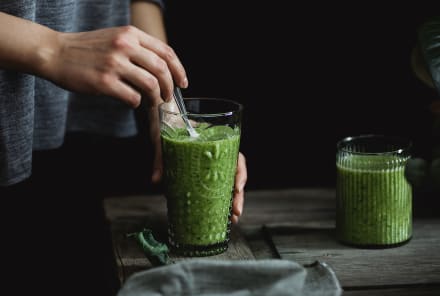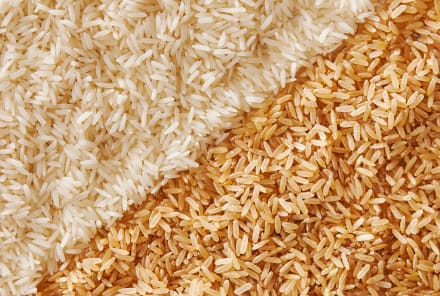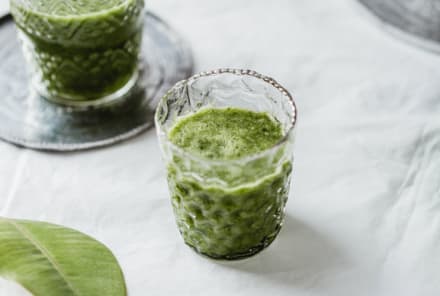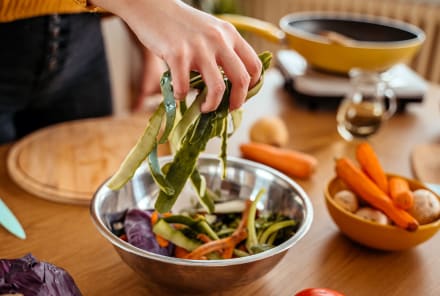Advertisement
17 Things I Wish Everyone Knew About Kale

This time of year, as the temperature cools, a molecular miracle is happening on farms everywhere: The kale is getting even better. Touched by the chill, kale gets sweeter as the sugars start to concentrate. And as the rest of the garden succumbs to the winter, kale stands strong.
Kale is a frequent topic of conversation in my life, especially as we ramp up to National Kale Day on October 7, which I co-founded. As kale has gained popularity, I've heard some scary comments from people who just don't know better. Like the woman who recently told me, with a knowing smile, that we "don’t absorb any nutrients from kale.” I've heard everything from worries that kale is harmful to human health to the misperception that it's a new food, so I thought it was time to set the record straight.
Here are 17 things I wish everyone knew about kale:
1. A serving of kale has more absorbable calcium than a small carton of milk.
#Gotkale?
2. Kale is medicine.
Modern health depends on eating more whole foods and plants, like kale. The mission of National Kale Day October 7 is to help change how we eat for the better. With your food choices affecting everything from personal health to environmental health, it's arguable that the fate of the planet depends upon us all eating more kale.
3. Kale tops the nutrient density scale.
It gives you more nutritional bang for your buck. Example? One cup of raw kale has just 33 calories yet contains 684 percent of our daily requirement of vitamin K, 134 percent of vitamin C, 206 percent of vitamin A, plus iron, folate, omega-3s, magnesium, calcium, iron, fiber, and 2 grams of protein. BAM! That’s nutrient density. For the full list of kale's health benefits, check out our explainer.
4. But kale's secret power is its phytonutrients, those miraculous molecules in plants that are often called “antioxidants.”
Kale possesses phytonutrients, which quell inflammation, improve the liver’s detox ability, and can even protect brain cells from stress. Kale talks to your DNA and tells it to sing the sweet, slow song of health and happiness.
5. But you say you are a kale zero?
Learn to be a kale hero! Check out the free Kale Hero Toolkit, which includes a kale prescription, kale experiments, recipes, and signs. It's available for download on NationalKaleDay.org.
6. Kale is not for everyone.
There are three groups of people who should avoid kale: (1) People taking blood thinners like Coumadin (warfarin). These folks should consult with their physician prior to changing their kale consumption, as all the vitamin K in kale can interfere with that medicine. (2) People who find kale very bitter are often “super tasters.” Sometimes, cooking kale makes it tolerable; sometimes not. (3) Those who have a cruciferous vegetable allergy. It's very rare, but some people are allergic to kale and other crucifers like broccoli, cabbage, and Brussels sprouts.
7. Being a kale fan doesn’t mean you have to eat a giant trough of kale salad at every meal or juice a bushel and swig it down with a smile.
Being a fan means appreciating the lessons and benefits of kale and the many other healthy, whole foods that sustain us. The average American eats 2 to 3 cups of kale every year — one of the healthiest foods on the planet. Is it any wonder our collective health is a mess?
8. Go slow, kale newbie. Start with kale chips, not a giant kale salad.
Be mindful as you introduce more roughage into your diet. I regularly give kale consultations and a typical complaint is something like, “OMG, I tried kale once and then was sooooo bloated.” If kale isn’t a part of your diet, give your body time to adjust.
9. Kale is a team player.
There’s been a nutrient smackdown lately — kale vs. collards, kale vs. broccoli, etc. First, kale is tired of people trying to turn cruciferous cousins against each other. Second, kale beats most greens like spinach in terms of nutrients. But rather than worrying about which vegetable is the best ... how about if we all just focus on helping people eat more plants?
10. Kale is not a fad.
With kale salad fatigue, some foodies are whispering that kale is a fad. It's true: Kale is having a spectacular, even unprecedented run. That said, kale is an Old World food and eaten across the globe; it's a staple in Scotland, Kenya, Denmark, Portugal, Italy, and many other countries. As we all get more focused on eating for health, kale will continue to be a staple for those in the know.
11. Kale does not cause hypothyroidism.
I’ve read many reports of people with hypothyroidism attributing their illness to kale. But scientific literature does not support the claim that eating kale can lead to thyroid problems.
There are molecules in kale called “goitergens” that can compete with iodine for uptake into the thyroid. Theoretically, a diet very low in iodine (seafood, seaweeds, iodized salt) and very high in kale (say, juicing a bushel of kale every day) could cause problems.
Based on the current science, a more appropriate worry would be eating excess iodine in seaweed and kelp or consuming too many environmental toxins like BVO, a chemical found in flame retardants and in many generic soda brands.
12. Organic matters but so does eating more plants.
Kale is on the list of the Environmental Working Group's “Dirty Dozen," a list of foods that you should try to buy organic because they can have more pesticides. You might not have the option of buying organic kale, and that's OK. I’d vote that the health benefits of eating kale (even if it's not organic) are much better than eating no kale.
13. The world of kale is vast and varied — keep exploring!
I’ve been inspired by the many tastes and colors of the dozens of varieties of kale: lacinato, redbor, Gulag Stars, True Siberian, Red Russian, White Russian, Dwarf Blue Vates, Red Nagoya, Chinese Kale, Sea Kale and the 6-foot-tall Walking Stick Kale. I hope you’ll seek out a kale you have not yet tried.
14. Kale offers unmatched culinary versatility.
Name another green that you can whip into a smoothie, toss into a salad, use to amp up your juice, sauté as a side, bake as a chip, or mix in a cocktail. #kalejito
15. Kale is an awesome deal.
A tasty bunch of 10 to 20 organic leaves costs two bucks. It's one of the few superfoods that's accessible to everyone, everywhere.
16. Kale is really easy to grow.
A group of students at the Indiana Academy of Science, Mathematics, and Humanities decided to grow kale for National Kale Day and planted some seeds. Now they have a kale patch in their courtyard.
17. You can absorb the nutrients in raw kale.
Cooking kale frees some nutrients like magnesium and decreases others, like heat-sensitive folate. But consuming kale in any form delivers fiber, protein, omega-3s, and a bevy of vitamins and minerals. I suggest mixing it up! I have myself on a steady rotation of sautéed kale, kale salads, kale chips, and kale smoothies.
Watch Next
Enjoy some of our favorite clips from classes
Enjoy some of our favorite clips from classes
What Is Meditation?
Mindfulness/Spirituality | Light Watkins
Box Breathing
Mindfulness/Spirituality | Gwen Dittmar
What Breathwork Can Address
Mindfulness/Spirituality | Gwen Dittmar
The 8 Limbs of Yoga - What is Asana?
Yoga | Caley Alyssa
Two Standing Postures to Open Up Tight Hips
Yoga | Caley Alyssa
How Plants Can Optimize Athletic Performance
Nutrition | Rich Roll
What to Eat Before a Workout
Nutrition | Rich Roll
How Ayurveda Helps Us Navigate Modern Life
Nutrition | Sahara Rose
Messages About Love & Relationships
Love & Relationships | Esther Perel
Love Languages
Love & Relationships | Esther Perel











